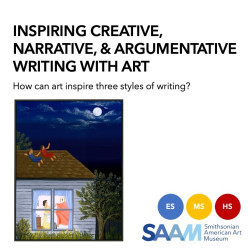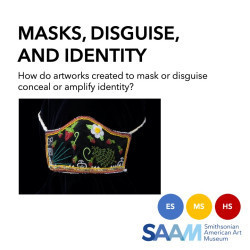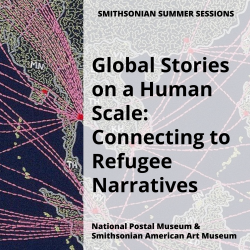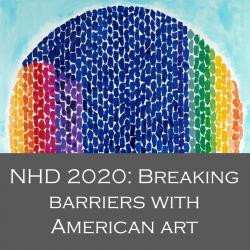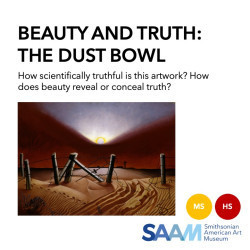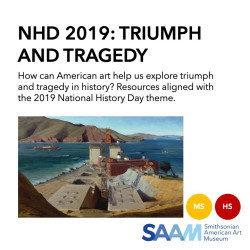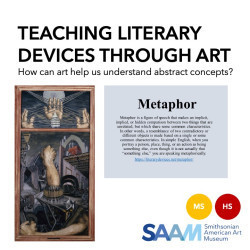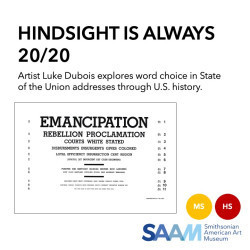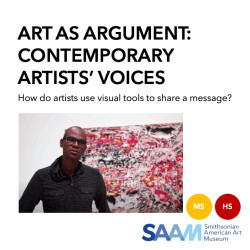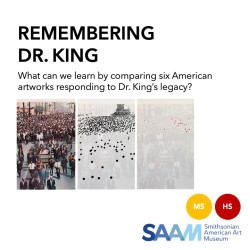Phoebe Hillemann
Teacher Institutes Educator
Smithsonian American Art Museum
As the Teacher Institutes Educator at the Smithsonian American Art Museum, I organize our week-long summer institutes for middle and high school English and social studies teachers: http://americanart.si.edu/institutes. I'm interested in interdisciplinary thinking, arts integration, and the power of dialogue in learning spaces.
Phoebe Hillemann's collections
Teaching Immigration & Migration through American Art
<p>Essential Question: How have immigration and migration –both voluntary and involuntary – shaped American culture?</p>
<p>This collection was created to support a session presented in the 2024 National Council for the Social Studies (NCSS) annual conference in Boston, MA. All artworks are from the Smithsonian American Art Museum's collection. </p>
<p>Explore more teaching resources from SAAM: <a href="https://americanart.si.edu/education/k-12/resources">https://americanart.si.edu/edu...</a></p>
 Phoebe Hillemann
Phoebe Hillemann
54
Inspiring Creative, Narrative, & Argumentative Writing with Art
<p>Explore different styles of writing in response to American art! This digital collection suggests artworks from the Smithsonian American Art Museum to use to inspire creative, narrative, and argumentative writing, along with suggested thinking routines and writing prompts. The categories are fluid -- many artworks can be used successfully for more than one type of writing!<br></p>
 Phoebe Hillemann
Phoebe Hillemann
37
William H. Johnson's Fighters for Freedom
<p>In the <em>Fighters for Freedom</em> William H. Johnson created a pantheon of historic and contemporary leaders who dedicated their lives to racial justice, individual accomplishment, and social equality. The series features African American abolitionists, scientists, teachers, performers and sports figures, and momentous meetings of allied heads of state.</p>
<p>Collection created to support a session at the 2021 National Council for Social Studies (NCSS) virtual conference.</p>
 Phoebe Hillemann
Phoebe Hillemann
31
SAAM General Resources
<p>This collection was created for the Smithsonian Summer Sessions for Teachers in July 2020, and contains resources related to the Smithsonian American Art Museum's breakout session as well as additional education resources for teachers and students.<br></p>
<p>#SummerSessions</p>
 Phoebe Hillemann
Phoebe Hillemann
30
Life in DC: Then and Now
<p>Explore images of Washington, DC, using artworks in the Smithsonian American Art Museum. Compare them to the present, learning about changing neighborhoods, people and daily life, natural resources, and arts & culture. This collection can be adapted for students of different grade levels learning about DC history.</p>
 Phoebe Hillemann
Phoebe Hillemann
38
Art as Argument: Dust Bowl to Climate Change
<p>How have American artists used visuals to bring attention to the pressing issues of their time? Compare and contrast a 1930s painting about the Dust Bowl with one addressing climate change made seventy years later, interpreting them in context to discover continuity and change over time. </p>
<p>Possible thinking questions for students to use with one or both paintings:</p>
<p></p>
<ul><li>Are these artworks primary sources? Does your answer depend on the context in which they are used?</li><li>What is "truthful" about these artworks? How might we use other sources to corroborate or check their truthfulness?</li><li>What do you think are the most effective media for making a compelling argument? Why? Student might consider speeches, photographs, newspaper op-eds, data visualizations like charts and graphs, videos/films, music, and visual art.</li></ul><p>Resources compiled for a March 2020 National Council for History Education (NCHE) conference session.<br /></p><p></p>
 Phoebe Hillemann
Phoebe Hillemann
11
Beauty and Truth: The Dust Bowl
<p>This collection explores Alexandre Hogue's 1933 painting <em>Dust Bowl</em> through a global thinking routine called "Beauty and Truth." Supporting materials help build historical and scientific context. </p>
<p><em>“Some may feel that in these paintings . . . I may have chosen an unpleasant subject, but after all the [drought] is most unpleasant. To record its beautiful moments without its tragedy would be false indeed. At one and the same time the [drought] is beautiful in its effects and terrifying in its results. The former shows peace on the surface but the latter reveals tragedy underneath. Tragedy as I have used it is simply visual psychology, which is beautiful in a terrifying way.” -Alexandre Hogue</em></p>
<p><br /></p>
 Phoebe Hillemann
Phoebe Hillemann
12
#BecauseOfHerStory: Exploring Untold Stories through Portraiture and American Art
<p>Learn how American art and portraiture can bring diverse women’s stories into your classroom, connecting with themes you may already teach. Discover strategies for engaging your students in close looking and critical thinking across disciplines. #SAAMTeach #NPGteach<br /></p>
<p>RELATED WEBINAR SERIES (recordings available): <a href="https://americanart.si.edu/education/k-12/professional-development/webinars">https://americanart.si.edu/education/k-12/professional-development/webinars</a></p>
<p>This project received support from the Smithsonian American Women’s History Initiative. To learn more, visit the <a href="https://womenshistory.si.edu/">Smithsonian American Women History Initiative website</a>. #BecauseOfHerStory</p>
<p><br /></p>
 Phoebe Hillemann
Phoebe Hillemann
19
Exploring Multiple Perspectives with American Art
<p>We started by doing a close reading of Walt Whitman's "I Hear America Singing," followed by an analysis of two paintings using Project Zero Thinking Routines:<br></p>
<ol><li><em>Iceman Crucified #4,</em> by Ralph Fasanella, using See, Think, Wonder</li><li><em>Braceros, </em>by Domingo Ulloa, using Step In, Step Out, Step Back</li></ol>
<p>Returning to the poem, consider how different people we identified in the two paintings might react to the poem. Next, choose two perspectives from any of the texts (written or visual) we've looked at, and use the Two Voice Poem template to compare their points of view on work in America.</p>
<p>Reflection Question: What do we gain by considering multiple perspectives on an issue?</p>
<p><em>This collection was created for the 2019 CATE annual convention in Burlingame, California. </em><br></p>
 Phoebe Hillemann
Phoebe Hillemann
7
Do Ho Suh: Almost Home
<p>Do Ho Suh’s immersive architectural installations—unexpectedly crafted with ethereal fabric—are spaces that are at once deeply familiar and profoundly alien. Suh is internationally renowned for his “fabric architecture” sculptures that explore the global nature of contemporary identity as well as memory, migration, and our ideas of home.</p>
<p>Suh was born in Korea and moved to the United States at the age of 29 in 1991, and he currently lives between New York, London, and Seoul. He crafts his works using traditional Korean sewing techniques combined with 3-D modeling and mapping technologies. Suh sees these works as “suitcase homes,” so lightweight and portable they can be installed almost anywhere.<br /></p>
<p>Essential Questions:</p>
<ul><li>What is home?
</li><li>How does perspective-taking help us better understand people, events, or issues?</li><li>How can artwork be used as a provocation for the exercise of higher order thinking and transdisciplinary application of content?</li></ul><p>Created for a program with the National Teachers of the Year on April 30, 2018.</p>
<p>#NTOY18</p><p><em>#visiblethinking</em><br /></p>
 Phoebe Hillemann
Phoebe Hillemann
13
Hindsight is Always 20/20
<p>In <em>Hindsight is Always 20/20</em>, Luke DuBois took the State of the Union addresses from each presidency (up through George W. Bush) and sorted them according to word frequency. The artist then printed the most frequently appearing works as an eye chart for each president, with the more frequently used words in larger type at the top of the chart and the less frequently used words toward the bottom. The traditional eye chart includes sixty-six letters; Luke DuBois’s charts substitute sixty-six words. The lists contain words that are not only important for the issues addressed by each president but also give an impression of how language was used at the time. Each of the forty-one presidencies to have State of the Union addresses at the time DuBois created this series (William Henry Harrison and James Garfield died before they could submit a single message to Congress) has its own eye chart. </p>
<p><em>Multiplicity</em>, 2011</p>
 Phoebe Hillemann
Phoebe Hillemann
42
Art as Argument: Contemporary Artists' Voices
<p>This collection explores the ways in which four American artists have used visual tools to share a message. In <em>Amendment #8</em>, Mark Bradford uses his layered paper and mixed media technique to challenge the viewer to consider how we are living up to the ideals of our founding documents. In <em>Portrait of Mnonja</em>, Mickalene Thomas references the art historical canon to address African American representation in museums. In <em>Life Magazine, April 19, 1968</em>, Alfredo Jaar manipulates a historical photograph to make visible the racial disparities it contains. And with her installation <em>Folding the Chesapeake</em>, Maya Lin begs us to see the critical importance of caring for the waterways around us. </p>
<p>Created for an April 16, 2018 webinar with Montana teachers.</p>
 Phoebe Hillemann
Phoebe Hillemann
12

